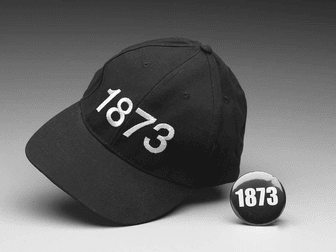Perez first heard about this Under State Supervision period in early 2011. "I was very angry about that. I was 7 years old when I was dragged here by my mother. So I had all the education from 3rd grade elementary school in Holland. I didn't get much from the Dutch history lessons, but the deliberate concealment of such a shameful and crucial fact infuriated me. Especially when one considers the socio-economic situation of the descendants. It infuriated me that the descendants of perpetrators and the "establishment" of the descendants of victims did everything they could to keep it that way as well. I had to do something with that. So it was that in February/March 2011, the time when we started working on plans and looking for money for slavery remembrance month in June, I came up with the idea for this button. Since we are always being fobbed off with a tip, with which we can hardly do any major activities, I had to cut my teeth. By way of reflection: the 400th anniversary of New York received €80,000,000 in tax money, in effect celebrating the extermination of the Manahatta Indians, compared to €750,00 for the 140th anniversary of the abolition of Dutch slavery. As the only distinguishable group in the Netherlands, we still do not have a nationwide stage. You read it right, 140- year anniversary!"
Caps and buttons
Initially, Perez came up with the idea of a cap with the year 1873. "However, I mentioned, the tip, I could never make that many caps to send a striking signal. A little quantum of caps would be a huge drain on the allocated budget. I then came up with the idea of making 25 caps on an exclusive scale and 500 buttons, same lettering, same color. Thus it happened. The 25 caps are a collector's item, at least for now. The cap is reserved only for persons whom I estimate and know are dedicated to the slavery record. For example, Kaikussi, Frank Mansro, Eddy Linthorst and Artwell Cain have caps. The button was worn en masse as a protest against the deliberate concealment of the truth. The 1st edition was 500 pieces, as was the 2nd edition."
Sweri
"I made a deal, a sweri, with myself. I will continue with this until it takes hold with the general public. As soon as there is money, more will be made and distributed to the descendants, with the story attached. Like me not long back, whole masses of descendants do not know about it and certainly our children do not know about it. I have two living in the house, teenage children, one in high school, the other in college. They have never been taught a piece of history about Suriname or slavery at their school. I myself, a few weeks before the final havo exam in 1975, was expelled from school because I had treated the history teacher unfairly, because she only paid half an A4 of attention to the ties with Suriname. That was in the year of independence, when you couldn't open a radio or TV or a newspaper or magazine without talking about Suriname. That was usually in negative terms about the huge exodus related to it. Perhaps you can still remember some newspaper headlines in which, for example, pastors from Zeeland called from the pulpit to resist the arrival of the black devil....... "Perez Jong Loy and his Association Opo Kondreman continue tirelessly to make the story of the history of slavery more visible. This includes wreath laying at the mayor's house and this year's canal parade on June 1. On that occasion, even the mayor wore the 1873 button. He was also the driving force behind the statue of Elieser at the Jewish cemetery in Ouderkerk aan de Amstel. He remains modest about his activities: "Now, having read the above, you must not think you are dealing with some creative or artistic genius. I myself don't know how I came up with the ideas. It just happened. I can't do anything about it."
